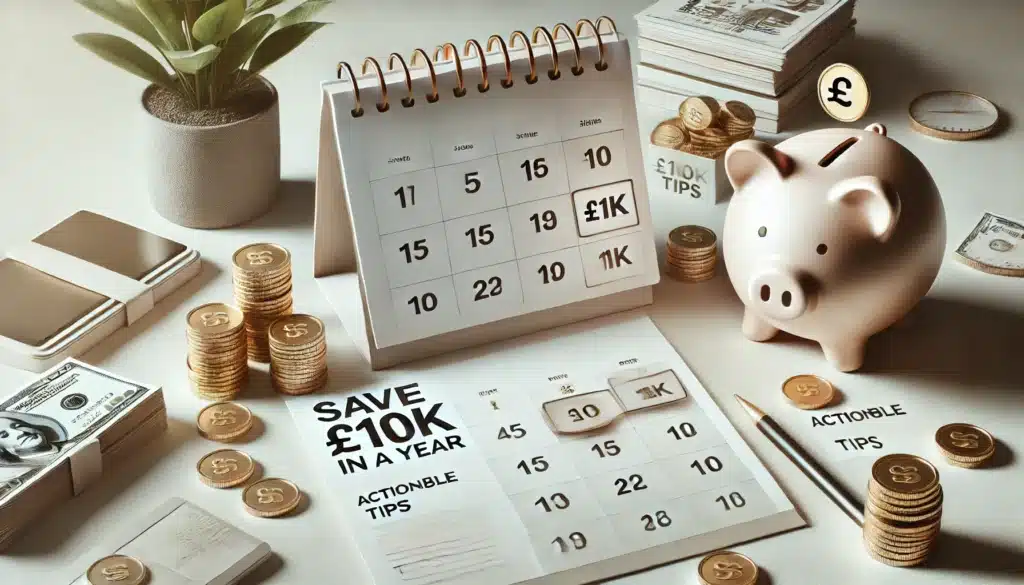
Quick Steps: In order to save £10k in a year, you’ll need to:
- Set a clear monthly savings goal: Aim to save approximately £834 each month.
- Create a strict budget: Cut unnecessary expenses and prioritize savings.
- Increase income: Take on side jobs or freelance work.
- Automate savings: Set up automatic transfers to your savings account.
- Monitor and adjust regularly: Review your progress monthly and adjust your strategy as needed.
IG - Best for Beginners

- Copy Trading Features Available
- Competitive Fees
Investing in financial products involves taking risk.
Your investments may increase or decrease in value, and losses may exceed the value of your original investment.
Interactive Brokers - Best for Experienced Investors

- Competitive Forex Spreads
- Advanced Trading Platforms
Investing in financial products involves taking risk.
Your investments may increase or decrease in value, and losses may exceed the value of your original investment.
1. Set a Clear Monthly Savings Goal
| Timeframe (Years) | No Interest | Fixed Interest (5%) | S&P 500 Average Return (10%)* |
|---|---|---|---|
| 1 | £10,008 | £10,240 | £11,000 |
| 2 | £20,016 | £22,166 | £24,200 |
| 3 | £30,024 | £33,488 | £33,100 |
| 4 | £40,032 | £45,087 | £46,410 |
| 5 | £50,040 | £57,004 | £64,010 |
Determine Your Annual Savings Target
When I first set out to save £10,000 in a year, it felt like an overwhelming goal. But breaking it down made it much more manageable. Start by determining exactly how much you want to save over the year. For example, £10,000 divided by 12 months gives you a clear target of £834 per month. Knowing this number is your first step—now you have a concrete goal to work toward each month.
Break Down the Goal into Manageable Steps
Hitting that £834 each month isn’t just about cutting costs—it’s about creating a plan that works for your life. I found it helpful to break this down further: how much do I need to save weekly? What daily habits can I change to make this happen? Whether it’s skipping a few takeout meals, carpooling to save on gas, or selling items you no longer need, these small changes add up. By focusing on these bite-sized goals, you make the larger target feel much more achievable.
Track Your Progress Monthly
One thing I can’t stress enough is the importance of tracking your progress. At the end of each month, take a moment to review how much you’ve saved. Did you hit your £834 target? If not, where did you fall short, and what can you do differently next month? I found that by consistently checking in on my progress, I stayed motivated and could adjust my strategies as needed. It’s not just about the numbers—it’s about creating a habit of saving and making it a natural part of your routine.
2. Create a Strict Budget
Identify Essential vs. Non-Essential Expenses
When I first started budgeting seriously, I realized I needed to get clear on what I truly needed versus what I just wanted. It can be eye-opening to see where your money goes each month. Essentials like rent, utilities, and groceries are non-negotiable, but what about that daily coffee or those streaming services? Listing out every expense and categorizing them as essential or non-essential is a great way to see where you can make adjustments.
Cut Back on Unnecessary Costs
Once you’ve identified your non-essential expenses, it’s time to make some tough decisions. I had to ask myself what I could live without, at least temporarily. For instance, I cut back on dining out, switched to a cheaper phone plan, and started using public transport more often. It wasn’t always easy, but knowing that these sacrifices were getting me closer to my savings goal made it worthwhile. Remember, you don’t have to cut out everything—just the things that aren’t adding significant value to your life.
Allocate a Specific Amount for Savings
With a clear understanding of your essential expenses and what you’ve cut back on, the next step is to allocate a specific amount of your income directly to savings. For me, this meant setting aside that £834 each month as soon as I got paid, treating it like any other bill. This way, I wasn’t tempted to spend it on something else. By making savings a priority, I ensured that I stayed on track to hit my goal. Even if you start with a smaller amount, the key is consistency—regularly putting money aside will build up over time.
| Category | Monthly Budget |
|---|---|
| Income | £2500 |
| Savings | £834 |
| Housing (Rent/Mortgage) | £700 |
| Utilities (Electricity, Gas, Water) | £150 |
| Groceries | £300 |
| Transportation | £150 |
| Dining Out | £50 |
| Entertainment | £50 |
| Shopping | £150 |
| Debt Repayment | £200 |
| Other | £100 |
| Total | £2500 |
3. Increase Your Income
Explore Side Hustles or Freelance Opportunities
When I realized that cutting costs alone wouldn’t get me to my savings goal as quickly as I wanted, I started looking for ways to boost my income. Side hustles were a game-changer. There are countless opportunities out there, from driving for ride-sharing services to offering freelance work online. I took on a few gigs that fit into my schedule, and it made a noticeable difference in my savings. It’s amazing how even a few extra hours a week can add up to significant earnings.
Leverage Skills for Additional Income
Think about the skills you already have and how you can turn them into extra cash. For me, it was writing and editing. I started freelancing on platforms like Upwork and Fiverr, offering my services to clients who needed content. Whether you’re good at graphic design, coding, tutoring, or even crafting, there’s likely a market for your skills. By monetizing what you already know, you can generate additional income without needing to invest in new training or tools.
Consider Selling Unused Items
We all have stuff lying around that we don’t use anymore. I took a hard look at my belongings and realized there was money to be made from items just collecting dust. I sold old electronics, clothes I no longer wore, and even some furniture I didn’t need. Platforms like eBay, Facebook Marketplace, and local consignment shops made it easy to turn these unused items into cash. Not only did this help boost my savings, but it also decluttered my space, which was an added bonus.
4. Automate Your Savings
Set Up Automatic Transfers
One of the most effective strategies I found for staying on track with my savings goal was automating the process. By setting up automatic transfers from my checking account to my savings account right after payday, I ensured that saving became a non-negotiable part of my financial routine. This way, I didn’t have to rely on willpower to set money aside each month—it happened automatically. If you’re serious about saving, this is a step you don’t want to skip.
Utilize Savings Apps and Tools
In addition to automatic transfers, I started using savings apps to help manage and boost my savings. Apps like Plum or Monzo offer features that round up your purchases and save the spare change, or set aside small amounts daily or weekly without you even noticing. These tools made it easier to save consistently and track my progress, giving me a clearer picture of how close I was to reaching my goal. Plus, they took a lot of the guesswork out of managing my savings.
Maintain Consistency to Build Savings
The key to successful saving is consistency. It’s not just about making one or two big deposits; it’s about regularly contributing to your savings, no matter how small the amount. Automating my savings helped with this, but I also made a point to review my savings progress regularly. This kept me motivated and ensured I was always moving forward. Even during months when I had unexpected expenses, I prioritized maintaining my savings habit, knowing that every little bit added up over time.
5. Monitor and Adjust Your Progress Regularly
Review Your Budget Monthly
One of the most important habits I developed while saving was taking the time each month to review my budget. This wasn’t just about looking at what I’d saved—it was about understanding where my money was going and whether my spending aligned with my goals. By regularly checking in, I could catch any overspending early and make the necessary adjustments. This monthly review became a crucial checkpoint, ensuring I stayed on track and avoided any surprises.
Make Adjustments Based on Spending Patterns
As I tracked my spending, I noticed patterns that I hadn’t considered before. There were months when unexpected expenses cropped up, or when I found myself spending more in certain categories. Instead of getting discouraged, I used this information to tweak my budget. For example, if I noticed I was consistently overspending on groceries, I would plan meals more carefully or switch to cheaper alternatives. These small adjustments helped me stay flexible while still prioritizing my savings.
Reassess Goals and Strategies as Needed
Saving is a dynamic process, and sometimes your initial plan needs to evolve. As I progressed, I found it helpful to reassess my goals and strategies every few months. If I was ahead of schedule, I might challenge myself to save a little more. If I was falling behind, I would reevaluate my approach—perhaps looking for additional income opportunities or cutting back further on non-essentials. This ongoing reassessment kept me engaged and motivated, ensuring that my savings plan remained realistic and achievable.
Conclusion
Saving £10,000 in a year might seem daunting at first, but with a clear plan and consistent effort, it’s entirely achievable. By setting realistic goals, creating a strict budget, finding ways to increase your income, automating your savings, and regularly monitoring your progress, you can steadily build your savings and reach your financial target. Remember, it’s not just about the destination—it’s about the habits you form along the way that will continue to benefit you long after you’ve reached your goal.
FAQs
If saving £834 per month feels out of reach, start with a smaller, more manageable amount and gradually increase it as you find ways to cut costs or boost your income. The key is to save consistently, even if the amount is less than your initial target.
Break your goal down into smaller milestones and celebrate your progress along the way. Regularly reviewing your budget and tracking your savings can also keep you motivated by showing how far you’ve come.
Consider taking on a side hustle, freelancing, or selling unused items around your home. Leveraging your skills for additional income through platforms like Upwork or Fiverr can also provide a quick boost.
Yes, using a separate savings account can help you keep track of your progress more easily and reduce the temptation to dip into your savings for non-essential expenses.
If you fall behind, reassess your budget and spending habits to identify areas for improvement. Consider adjusting your savings goal or finding new ways to increase your income to get back on track.

 Seasoned finance professional with 10+ years' experience. Chartered status holder. Proficient in CFDs, ISAs, and crypto investing. Passionate about helping others achieve financial goals.
Seasoned finance professional with 10+ years' experience. Chartered status holder. Proficient in CFDs, ISAs, and crypto investing. Passionate about helping others achieve financial goals.